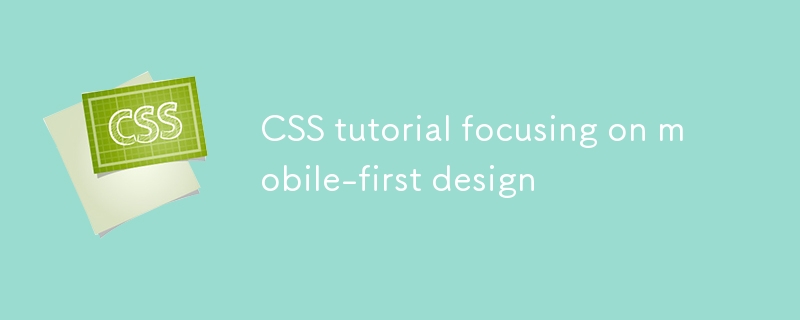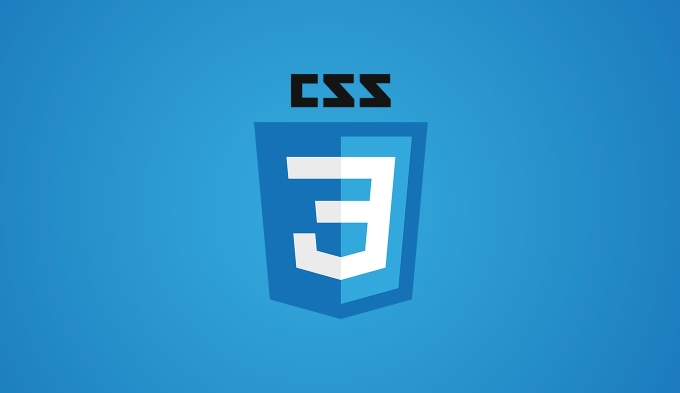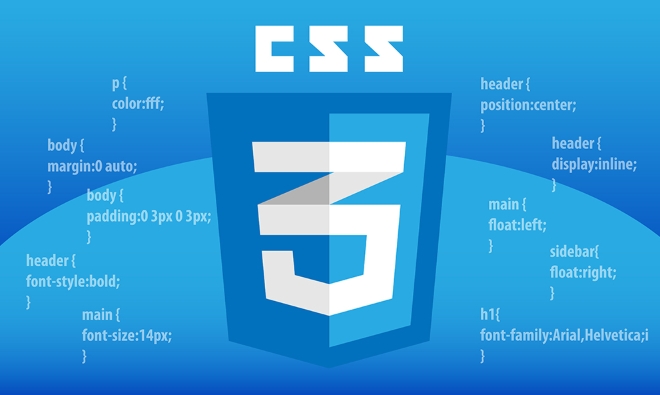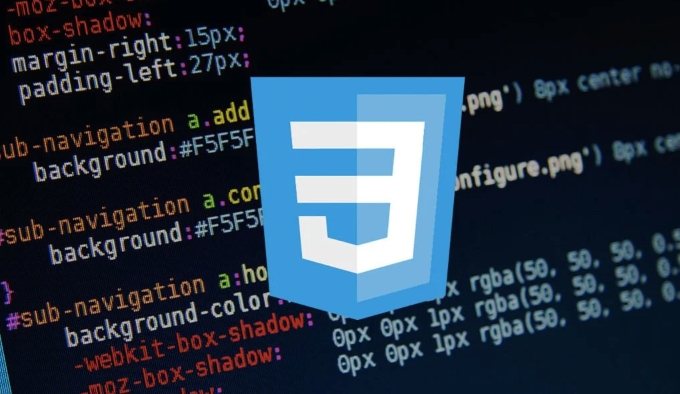CSS tutorial focusing on mobile-first design
Jul 02, 2025 am 12:52 AMMobile-first CSS design requires setting the viewport meta tag, using relative units, styling from small screens up, optimizing typography and touch targets. First, add <meta name="viewport" content="width=device-width, initial-scale=1"> to control scaling. Second, use %, em, or rem instead of pixels for flexible layouts. Third, write base styles for mobile, then layer in tablet and desktop styles with media queries. Fourth, ensure text is readable with at least 16px font and clickable elements are at least 44x44px. Fifth, avoid absolute positioning that causes overlap, favoring Flexbox or Grid. Finally, test layouts by resizing the browser and adjust tap targets near screen edges to prevent gesture conflicts.

Getting your CSS right for mobile-first design isn’t about doing something fancy — it’s about thinking ahead. The idea is simple: build your site for the smallest screen first, then scale up. This approach helps you keep things clean and functional from the start, rather than trying to squeeze a desktop layout onto a phone later.

Use Responsive Viewports
One of the first things you need to do in any mobile-first project is set the viewport meta tag properly. Without this, mobile browsers will act like they’re viewing a desktop site and zoom out by default.

Add this line inside your HTML <head>:
<meta name="viewport" content="width=device-width, initial-scale=1">
This tells the browser not to scale the page automatically and to match the device width. It might seem minor, but skipping this step breaks the whole responsive experience on mobile.

Also, when designing with CSS, use relative units like percentages, em, or rem instead of fixed pixels. For example:
- Set widths using
%orvw - Use
remfor font sizes so text scales nicely across devices - Avoid setting elements with fixed heights unless absolutely necessary
These small choices make your layout adapt better without extra hacks later.
Start Styling from Small Screens
In your CSS file, write styles for mobile devices first. That means your base styles are built for smaller screens. Then, as screens get bigger, you layer on changes using media queries.
Here’s how that looks:
/* Base styles (mobile) */
.container {
padding: 1rem;
}
/* Tablet and up */
@media (min-width: 768px) {
.container {
padding: 2rem;
}
}
/* Desktop and up */
@media (min-width: 1024px) {
.container {
max-width: 1200px;
margin: 0 auto;
}
}Some tips to keep in mind:
- Keep your media query breakpoints simple and consistent
- Don’t go overboard with too many different screen sizes
- Think in terms of content needs, not specific devices
It’s also good practice to test your layout by resizing your browser window. You’ll quickly see where things break or look off.
Optimize Typography and Touch Targets
Text readability and touch targets are often overlooked but are super important on mobile. Big blocks of tiny text are frustrating to read, and small buttons are annoying to tap.
To fix that:
- Use at least
16pxfont size for body text - Make sure clickable elements (like buttons and links) are big enough — around
44x44pxminimum - Add enough spacing between interactive elements
Also, avoid using absolute positioning too much for layout, especially if it causes overlapping elements on smaller screens. Flexbox and Grid work great and are easier to manage responsively.
Another thing — don’t forget about tap targets near the edges of the screen. On some phones, especially iOS, the system gestures can interfere with taps near the bottom or sides. So, give those elements a bit of breathing room.
That’s the core of mobile-first CSS. It doesn’t require complicated tools or frameworks — just thoughtful planning and smart use of basic CSS features. Keep things simple, test early, and adjust as needed.
The above is the detailed content of CSS tutorial focusing on mobile-first design. For more information, please follow other related articles on the PHP Chinese website!

Hot AI Tools

Undress AI Tool
Undress images for free

Undresser.AI Undress
AI-powered app for creating realistic nude photos

AI Clothes Remover
Online AI tool for removing clothes from photos.

Clothoff.io
AI clothes remover

Video Face Swap
Swap faces in any video effortlessly with our completely free AI face swap tool!

Hot Article

Hot Tools

Notepad++7.3.1
Easy-to-use and free code editor

SublimeText3 Chinese version
Chinese version, very easy to use

Zend Studio 13.0.1
Powerful PHP integrated development environment

Dreamweaver CS6
Visual web development tools

SublimeText3 Mac version
God-level code editing software (SublimeText3)

Hot Topics
 How to use PHP to build social sharing functions PHP sharing interface integration practice
Jul 25, 2025 pm 08:51 PM
How to use PHP to build social sharing functions PHP sharing interface integration practice
Jul 25, 2025 pm 08:51 PM
The core method of building social sharing functions in PHP is to dynamically generate sharing links that meet the requirements of each platform. 1. First get the current page or specified URL and article information; 2. Use urlencode to encode the parameters; 3. Splice and generate sharing links according to the protocols of each platform; 4. Display links on the front end for users to click and share; 5. Dynamically generate OG tags on the page to optimize sharing content display; 6. Be sure to escape user input to prevent XSS attacks. This method does not require complex authentication, has low maintenance costs, and is suitable for most content sharing needs.
 PHP creates a blog comment system to monetize PHP comment review and anti-brush strategy
Jul 25, 2025 pm 08:27 PM
PHP creates a blog comment system to monetize PHP comment review and anti-brush strategy
Jul 25, 2025 pm 08:27 PM
1. Maximizing the commercial value of the comment system requires combining native advertising precise delivery, user paid value-added services (such as uploading pictures, top-up comments), influence incentive mechanism based on comment quality, and compliance anonymous data insight monetization; 2. The audit strategy should adopt a combination of pre-audit dynamic keyword filtering and user reporting mechanisms, supplemented by comment quality rating to achieve content hierarchical exposure; 3. Anti-brushing requires the construction of multi-layer defense: reCAPTCHAv3 sensorless verification, Honeypot honeypot field recognition robot, IP and timestamp frequency limit prevents watering, and content pattern recognition marks suspicious comments, and continuously iterate to deal with attacks.
 How to build a PHP Nginx environment with MacOS to configure the combination of Nginx and PHP services
Jul 25, 2025 pm 08:24 PM
How to build a PHP Nginx environment with MacOS to configure the combination of Nginx and PHP services
Jul 25, 2025 pm 08:24 PM
The core role of Homebrew in the construction of Mac environment is to simplify software installation and management. 1. Homebrew automatically handles dependencies and encapsulates complex compilation and installation processes into simple commands; 2. Provides a unified software package ecosystem to ensure the standardization of software installation location and configuration; 3. Integrates service management functions, and can easily start and stop services through brewservices; 4. Convenient software upgrade and maintenance, and improves system security and functionality.
 What are common CSS browser inconsistencies?
Jul 26, 2025 am 07:04 AM
What are common CSS browser inconsistencies?
Jul 26, 2025 am 07:04 AM
Different browsers have differences in CSS parsing, resulting in inconsistent display effects, mainly including the default style difference, box model calculation method, Flexbox and Grid layout support level, and inconsistent behavior of certain CSS attributes. 1. The default style processing is inconsistent. The solution is to use CSSReset or Normalize.css to unify the initial style; 2. The box model calculation method of the old version of IE is different. It is recommended to use box-sizing:border-box in a unified manner; 3. Flexbox and Grid perform differently in edge cases or in old versions. More tests and use Autoprefixer; 4. Some CSS attribute behaviors are inconsistent. CanIuse must be consulted and downgraded.
 What is the accent-color property?
Jul 26, 2025 am 09:25 AM
What is the accent-color property?
Jul 26, 2025 am 09:25 AM
accent-color is an attribute used in CSS to customize the highlight colors of form elements such as checkboxes, radio buttons and sliders; 1. It directly changes the default color of the selected state of the form control, such as changing the blue check mark of the checkbox to red; 2. Supported elements include input boxes of type="checkbox", type="radio" and type="range"; 3. Using accent-color can avoid complex custom styles and extra DOM structures, and maintain native accessibility; 4. It is generally supported by modern browsers, and old browsers need to be downgraded; 5. Set accent-col
 Describe the `vertical-align` property and its typical use cases
Jul 26, 2025 am 07:35 AM
Describe the `vertical-align` property and its typical use cases
Jul 26, 2025 am 07:35 AM
Thevertical-alignpropertyinCSSalignsinlineortable-cellelementsvertically.1.Itadjustselementslikeimagesorforminputswithintextlinesusingvalueslikebaseline,middle,super,andsub.2.Intablecells,itcontrolscontentalignmentwithtop,middle,orbottomvalues,oftenu
 CSS transitions tutorial
Jul 26, 2025 am 09:30 AM
CSS transitions tutorial
Jul 26, 2025 am 09:30 AM
CSStransitionsenablesmoothpropertychangeswithminimalcode,idealforhovereffectsandinteractivefeedback.1.Usethesyntaxtransition:propertydurationtiming-functiondelay;todefinetransitions,liketransition:background-color0.3sease0.1s;.2.Specifytransition-pro
 How to change text color in CSS?
Jul 27, 2025 am 04:25 AM
How to change text color in CSS?
Jul 27, 2025 am 04:25 AM
To change the text color in CSS, you need to use the color attribute; 1. Use the color attribute to set the text foreground color, supporting color names (such as red), hexadecimal codes (such as #ff0000), RGB values (such as rgb(255,0,0)), HSL values (such as hsl(0,100%,50%)), and RGBA or HSLA with transparency (such as rgba(255,0,0,0.5)); 2. You can apply colors to any element containing text, such as h1 to h6 titles, paragraph p, link a (note the color settings of different states of a:link, a:visited, a:hover, a:active), buttons, div, span, etc.; 3. Most






